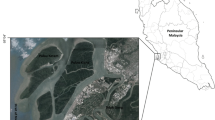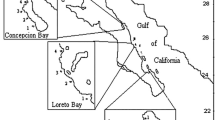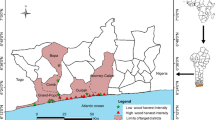Abstract
We used a stratified random sampling design to inventory the mangrove vegetation within the Zambezi River Delta, Mozambique, to provide a basis for estimating biomass pools. We used canopy height, derived from remote sensing data, to stratify the inventory area, and then applied a spatial decision support system to objectively allocate sample plots among five strata. Height and diameter were measured on overstory trees, saplings and standing dead trees in nested plots, and biomass was calculated using allometric equations. Each of the eight mangrove species occurring in Mozambique exist within the Delta. They are distributed in heterogeneous mixtures within each of the five canopy height classes, not reflecting obvious zonation. Overstory trees averaged approximately 2000 trees ha−1, and average basal area ranged from 14 to 41 m2 ha−1 among height classes. The composition of the saplings tended to mirror the overstory, and the diameter frequency distributions suggest all-aged stands. Above-ground biomass ranged from 111 to 483 Mg ha−1 with 95 % confidence interval generally within 15 % of the height class mean. Despite over 3000 trees ha−1 in the small-tree component, 92 % of the vegetation biomass is in the overstory live trees. The objective inventory design proved effective in estimating forest biomass within the 30,267 ha mangrove forest.




Similar content being viewed by others
References
Alongi DM (2002) Present state and future of the world’s mangrove forests. Environ Conserv 29:331–349
Alongi DM (2012) Carbon sequestration in mangrove forests. Carbon Manag 3:313–322
Alongi DM (2014) Carbon cycling and storage in mangrove forests. Annu Rev Mar Sci 6:195–219
Barbosa FMA, Cuambe CC, Bandeira SO (2001) Status and distribution of mangroves in Mozambique. S Afr J Bot 67:393–398
Beentje H, Bandeira S (2007) Field guide to the mangrove trees of Africa and Madagascar. Kew Publishing, Surrey
Beilfuss RD, Moore D, Bento C, Dutton P (2001) Patterns of Vegetation Change in the Zambezi Delta, Mozambique
Bento CM, Beilfuss RD, Hockey PA (2007) Distribution, structure and simulation modelling of the Wattled Crane population in the Marromeu Complex of the Zambezi Delta, Mozambique. Ostrich J Afr Ornithol 78:185–193
Cochran WG (1977) Sampling techniques, 3rd edn. Wiley, New York, p 428
Densham PJ (1991) Spatial decision support systems. In: Maguire DJ, Rhind DW (eds) Geographical Information Systems: Prinicples and Applications. Wiley, New York, pp 403–412
Ellison AA, Murkherjee BB, Karim A (2000) Testing patterns of zonation in mangroves: scale dependence and environmental correlates inn the Sundarbans of Bagladesh. J Ecol 88:813–824
Fatoyinbo T, Simard M (2013) Height and biomass of mangroves in Africa from ICESat/GLAS and SRTM. Int J Remote Sens 34:668–681
Fromard F, Puig H, Mougin E, Marty G, Betoulle JL, Cadamuro L (1998) Structure, above ground biomass and dynamics of mangrove ecosystems: new data from French Guiana. Oecologia 115:39–53
GRID-Arendal (2013) Atlas of the changing environment—Zambezi River Basin. http://www.grida.no/graphicslib/detail/zambezi-river-basin-average-temperature_8c75
Hoguane AM (2007) Perfil Diagnóstico da Zona Costeira de Moçambique. Revista de Gestão Costeira Integrada 7:69–82
Howard J, Hoyt S, Isensee K, Pidgeon E, Telszewski M (eds.) (2014) Coastal blue carbon: methods for assessing carbon stocks and emissions factors in mangroves, tidal salt marshes, and seagrass meadows. Conservation International, Intergovernmental Oceanographic Commission of UNESCO, International Union for Conservation of Nature. Arlington, Virginia, USA
Institute SAS (2011) SAS/STAT 9.3 User’s Guide. SAS Institute Inc., Cary, North Carolina
Jones TG, Ratsimba HR, Ravaoarinorotsihoarana L, Gripps G, Bey A (2014) Ecological variability and carbon stock estimates of mangrove ecosystems in northwestern Madagascar. Forests 5:177–205
Kathiresan K, Bingham BL (2001) Biology of mangrove and mangrove ecosystems. Adv Mar Biol 40:81–251
Kauffman JB, Donato DC (2012) Protocols for the measurement, monitoring and reporting of structure, biomass and carbon stocks in mangrove forests. Center for International Forestry Research, Bogor
Kauffman JB, Heider C, Norfolk J, Payton F (2014) Carbon stocks of intact mangroves and carbon emissions from their conversion in the Dominican Republic. Ecol Appl 24(3):518–527
Komiyama A, Ogino K, Aksornkoae S, Sabhasri S (1987) Root biomass of a mangrove forest in Southern Thailand. 1. Estimation by the trench method and the zonal structure of root biomass. J Trop Ecol 3:97–108
Komiyama A et al (2000) Top/root biomass ratio of a secondary mangrove (Cerips tagal (Perr.) C.B. Rob.) forest. For Ecol Manag 139:127–134
Komiyama A, Poungparn S, Kato S (2005) Common allometric equations for estimating the tree weight of mangroves. J Trop Ecol 21:471–477
Komiyama A, Ong JE, Poungparn S (2008) Allometry, biomass, and productivity of mangrove forests: a review. Aquat Bot 89:128–137
Matthijs S, Tack J, van Speybrock D, Noedam N (1999) Mangrove species zonation and soil redox state, sulfide concentration and salinity in Gazi Bay (Kenya), a preliminary study. Mangroves Salt Marshes 3:243–249
Pool DJ, Snedaker SC, Lugo AE (1977) Structure of mangrove forests in Florida, Puerto Rico, México and Costa Rica. Biotropica 9(3):195–212
Rahman MM, Khan MNI, Hoque AKF, Ahmed I (2014) Carbon stock in the Sundarbans mangrove forest: spatial variations in vegetation types and salinity zones. Wetl Ecol Manag. doi:10.1007/s11273-014-9379-x
Ross MS, Ruiz PL, Teleskicki GJ, Meeder JF (2001) Estimating above-ground biomass and production in mangrove communities of Biscayne National Park, Florida (U.S.A.). Wetl Ecol Manag 9:27–37
Saenger P (2002) Mangrove ecology, silviculture and conservation. Springer Science, Dordrecht, p 351
Sherman R, Fahey TJ, Battles JJ (2000) Small-scale disturbance and regeneration dynamics in a neotropical mangrove forest. J Ecol 88:165–178
Sherman R, Fahey TJ, Martinz P (2003) Patterns of biomass, and aboveground net primary productivity in a mangrove ecosystem in the Dominican Republic. Ecosystems 6:384–398
Sitoe AL, Mandlate JC, Guedes BS (2014) Biomass and carbon stocks of Sofala Bay Mangrove Forests. Forests 5:1967–1981
Smith TJ (1992) Forest Structure. pp 101–136 In: Robertson, A.I. & Alongi, D.M., (eds.), Tropical mangrove ecosystems. Coastal & Estuarine Studies #41, American Geophysical Union, Washington, D.C
Vilankulos M, Marquez MR (2000) Physical characterization of the coastal zone of mangrove areas in the districts of Dondo and Marromeu, Sofala, based on interpretation of aerial photographs, vol 1. Direcçao Nacional de Florestas e Fauna Bravia, Maputo
Wang G, Guan D, Peart MR, Chen Y (2013) Ecosystem carbon stocks of mangrove forests in Yingluo Bay, Guangdong Provice of South China. For Eco Manag 310:539–546
World Agroforestry Center (2013) Wood density database. http://worldagroforestry.org/regions/southeast_asia/resources/wood-density-database
Acknowledgments
Dr. Wenwu Tang, Univ. North Carolina—Charlotte, conducted the geospatial analyses for the stratified random sampling design, and developed the Spatial Decision Support System for objective allocation of sample plots. Denise Nicolau, Itelvino Cunat, and Rito Mabunda provided invaluable logistical support during the planning and implementation of field missions. Célia Macamo and Salamão Bandeira assisted prior to, and during field work, with identification of mangrove and other plant species. The success of this project would not have been possible without the hard work and dedication of the 2012 and 2013 mission field crews. This work was made possible by US AID support to the USFS under the US AID Mozambique Global Climate Change Sustainable Landscape Program, in collaboration with the Natural Resource Assessment Department of the Government of Mozambique.
Funding
Funds for this work were provided by the US Agency for International Development and the US Dept. of Agriculture, Forest Service.
Author information
Authors and Affiliations
Corresponding author
Electronic supplementary material
Below is the link to the electronic supplementary material.
Supplementary material 1 (PDF 280 kb)
Supplement #1. Test of differences between height class and species means of the structural attributes for overstory trees (DBH > 5 cm), performed with Satterthwaite two-sample t test at the 0.05 Type I error rate. The value in each box is the p-value from the test between the species for that column and row. The far right column and bottom row of each table represents unknown species. Species numbers 1-8 correspond to the species headings in Tables 2-4; in numerical order- C. tagal, B. gymnorrhiza, X. granatum, S. alba, A. marina, R. mucronata, H. littoralis, L. racemosa. Empty boxes represent a test that could not be completed due to one of the species not being present in that height class
Supplementary material 2 (PDF 255 kb)
Supplement #2. Test of differences between height class and species means of the structural attributes for saplings (DBH < 5 cm), performed with Satterthwaite two-sample t-test at the 0.05 Type I error rate. The value in each box is the p-value from the test between the species for that column and row. The far right column and bottom row of each table represents unknown species. Species numbers 1-8 correspond to the species headings in Tables 2-4; in numerical order- C. tagal, B. gymnorrhiza, X. granatum, S. alba, A. marina, R. mucronata, H. littoralis, L. racemosa. Empty boxes represent a test that could not be completed due to one of the species not being present in that height class
Supplementary material 3 (PDF 269 kb)
Supplement #3. Test of differences between height class and species means of the structural attributes for standing dead trees, performed with Satterthwaite two-sample t-test at the 0.05 Type I error rate. The value in each box is the p-value from the test between the species for that column and row. The far right column and bottom row of each table represents unknown species. Species numbers 1-8 correspond to the species headings in Tables 2-4; in numerical order- C. tagal, B. gymnorrhiza, X. granatum, S. alba, A. marina, R. mucronata, H. littoralis, L. racemosa. Empty boxes represent a test that could not be completed due to one of the species not being present in that height class
Rights and permissions
About this article
Cite this article
Trettin, C.C., Stringer, C.E. & Zarnoch, S.J. Composition, biomass and structure of mangroves within the Zambezi River Delta. Wetlands Ecol Manage 24, 173–186 (2016). https://doi.org/10.1007/s11273-015-9465-8
Received:
Accepted:
Published:
Issue Date:
DOI: https://doi.org/10.1007/s11273-015-9465-8




